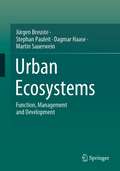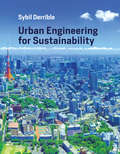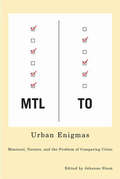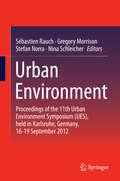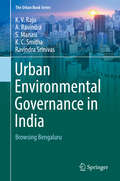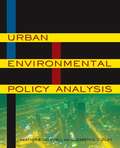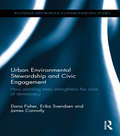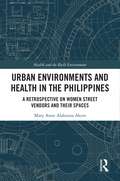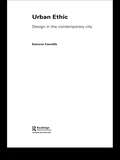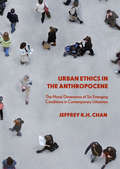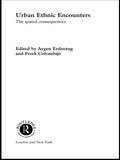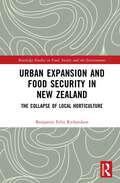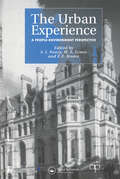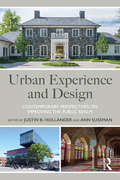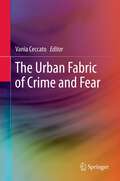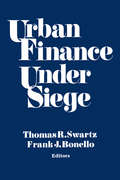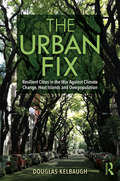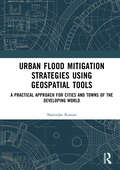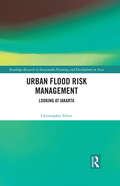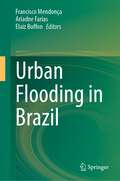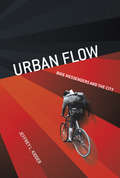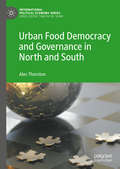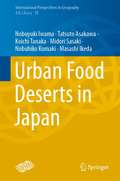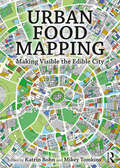- Table View
- List View
Urban Ecosystems: Function, Management and Development
by Jürgen Breuste Stephan Pauleit Dagmar Haase Martin SauerweinThis textbook on urban ecosystems answers important questions about the ecological structure, functions and socio-ecological development of cities worldwide. Based on how cities are developing today in an increasingly urbanized world, it explains ecological challenges for cities of the 21st century such as resource efficiency, climate change, moderation of quality of life and resilience. The book combines theories of urban development and ecology with practical applications and case studies, thus identifying potential for improvement and examples of good ecological urban development worldwide. It shows that cities are by far not only problem areas but also offer great potential for a good life and that the various urban ecosystems can make a considerable contribution to this. The "eco-city" is thus not a utopia,but a real goal that can be pursued step by step in a targeted manner, taking into account the local and regional context.Four renowned urban ecologists have contributed their specific experience in sub-areas without losing sight of the big picture. Jürgen Breuste is an urban ecologist and works at the Paris Lodron University in Salzburg, Austria, on the topics of sustainable urban development, urban biodiversity, ecosystem services and eco-cities. Dagmar Haase is Landschaftsökologin and works at the Humboldt University of Berlin on urban ecosystem services and land use modeling. Stephan Pauleit is a landscape planner and works at the Technical University of Munich on strategies for the sustainable development of urban landscapes. Martin Sauerwein is a geographer and works at the University of Hildesheim on geo-ecology in cultural landscapes, geoarchaeology and soil protection.The textbook addresses a broad audience of students, teachersand also to practitioners in the fields of ecology, urban ecology, urban development, sustainability, urban geography, nature and landscape conservation, spatial planning, landscape ecology, social sciences and urban studies. The numerous photos and graphics, many of them in four colors, as well as clear tables illustrate the facts. Case studies, examples and explanations allow a deeper insight. Questions at the end of each chapter allow the progress of knowledge to be checked, and a comprehensive bibliography for each chapter provides further studies.This book is a translation of the original German 1st edition Stadtökosysteme by Jürgen Breuste published by Springer Fachmedien Wiesbaden GmbH, part of Springer Nature in 2016. The translation was done with the help of artificial intelligence (machine translation by the service DeepL.com). A subsequent human revision was done primarily in terms of content, so that the book will read stylistically differently from a conventional translation. Springer Nature works continuously to further the development of tools for the production of books and on the related technologies to support the authors.This springer essential is a translation of the original German 1st edition essentials,Stadtökosysteme by Jürgen Breuste published by Springer Fachmedien Wiesbaden GmbH, part of Springer Nature in 2016. The translation was done with the help of artificial intelligence (machine translation by the service DeepL.com). A subsequent human revision was done primarily in terms of content, so that the book will read stylistically differently from a conventional translation. Springer Nature works continuously to further the development of tools for the production of books and on the related technologies to support the authors.
Urban Engineering for Sustainability (The\mit Press Ser.)
by Sybil DerribleA textbook that introduces integrated, sustainable design of urban infrastructures, drawing on civil engineering, environmental engineering, urban planning, electrical engineering, mechanical engineering, and computer science.This textbook introduces urban infrastructure from an engineering perspective, with an emphasis on sustainability. Bringing together both fundamental principles and practical knowledge from civil engineering, environmental engineering, urban planning, electrical engineering, mechanical engineering, and computer science, the book transcends disciplinary boundaries by viewing urban infrastructures as integrated networks. The text devotes a chapter to each of five engineering systems—electricity, water, transportation, buildings, and solid waste—covering such topics as fundamentals, demand, management, technology, and analytical models. Other chapters present a formal definition of sustainability; discuss population forecasting techniques; offer a history of urban planning, from the Neolithic era to Kevin Lynch and Jane Jacobs; define and discuss urban metabolism and infrastructure integration, reviewing system interdependencies; and describe approaches to urban design that draw on complexity theory, algorithmic models, and machine learning. Throughout, a hypothetical city state, Civitas, is used to explain and illustrate the concepts covered. Each chapter includes working examples and problem sets. An appendix offers tables, diagrams, and conversion factors. The book can be used in advanced undergraduate and graduate courses in civil engineering and as a reference for practitioners. It can also be helpful in preparation for the Fundamentals of Engineering (FE) and Principles and Practice of Engineering (PE) exams.
Urban Enigmas: Montreal, Toronto, and the Problem of Comparing Cities (Culture of Cities #2)
by Johanne SloanContributors, part of the collaborative research project The Culture of Cities: Montreal, Toronto, Dublin, and Berlin, address theoretical and methodological aspects of comparison, while case-studies examine the mutually constituted identities of Montreal and Toronto through examples of travel writing, public art, film festivals, theatrical performances, diasporic communities, ethnic festivals, and urban media. Comparison is shown to be not only something performed by experts but a deeply embedded, everyday social practice that contributes to the mutable identities of cities. Urban Enigmas demonstrates that the accumulation of urban actions, encounters, experiences, and relationships create distinctive patterns that make it possible to recognize the particularity of cities.
Urban Enigmas: Montreal, Toronto, and the Problem of Comparing Cities (Culture of Cities Series)
by Johanne SloanContributors, part of the collaborative research project The Culture of Cities: Montreal, Toronto, Dublin, and Berlin, address theoretical and methodological aspects of comparison, while case-studies examine the mutually constituted identities of Montreal and Toronto through examples of travel writing, public art, film festivals, theatrical performances, diasporic communities, ethnic festivals, and urban media. Comparison is shown to be not only something performed by experts but a deeply embedded, everyday social practice that contributes to the mutable identities of cities. Urban Enigmas demonstrates that the accumulation of urban actions, encounters, experiences, and relationships create distinctive patterns that make it possible to recognize the particularity of cities.
Urban Environment
by Sébastien Rauch Gregory Morrison Stefan Norra Nina SchleicherOver half of the global population now lives in cities. This ongoing urbanisation is making it increasingly important to adequately manage urban systems and preserve urban environments. This book is the outcome of the 11th Urban Environment Symposium (UES) held on 16-19 September 2012 in Karlsruhe, Germany. The UES aims at providing a forum on the sciences and practices needed to promote a sustainable future in urban environments. Papers by leading experts are presented in sections on Urban Management and Spatial Planning, Green Cities and Urban Ecosystems, Urban Planning and Development, Air Quality and Noise, Urban Climate Change and Adaptation, and Contamination of Urban Waters and its Effects.
Urban Environmental Governance in India: Browsing Bengaluru (The Urban Book Series)
by Ravindra Srinivas K. C. Smitha S. Manasi A. Ravindra K. V. RajuThis book aims to identify the challenges presented by current urban environmental governance practices in fast growing Indian cities, to propose changes to the current governance implementation strategies, and to explore the best practices to achieve sustainable urban models through Indian and global perspectives. With a focus on the city of Bengaluru, the book draws on extensive reviews of literature and data to present current trends and statuses of environmental resource use in growing urban centres of India.The book analyzes the situations that impact urban environmental governance decisions and outcomes and proposes solutions to address these issues for long-term sustainability. Policy makers, researchers, academics and development practitioners in environmental politics and urban governance will find this work of great interest.The book starts by examining different urban environmental threats on global and domestic levels, and provides evidence for the effectiveness of sustainable efforts to curb the impact of crisis-like scenarios. Then the book discusses the role of institutional regimes in influencing urban environmental outcomes through policies, and analyzes the role of various actors in the evolution of urban environmental governance from a legal perspective at global and local scales. In the final chapters, the book explores the trends and status of environmental resource management in Bangalore Metropolitan Area (BMA), and examines the dynamics of local institutions and governance structures for regulating environmental governance for promoting effective sustainable environmental governance in Bengaluru.
Urban Environmental Policy Analysis
by Heather E. Campbell Elizabeth A CorleyThis timely book provides a wealth of useful information for following through on today's renewed concern for sustainability and environmentalism. It's designed to help city managers, policy analysts, and government administrators think comprehensively and communicate effectively about environmental policy issues.The authors illustrate a system-based framework model of the city that provides a holistic view of environmental media (land, air, and water) while helping decision-makers to understand the extent to which environmental policy decisions are intertwined with the natural, built, and social systems of the city. They go on to introduce basic and environment-specific policy-analytic models, methods, and tools; presents numerous specific environmental policy puzzles that will confront cities; and introduces methods for understanding and educating public opinions around urban environmental policy.The book is grounded in the policy-analytic perspective rather than political science, economic, or planning frameworks. It includes both new scholarship and synthesis of existing policy analysis. Numerous tables, figures, checklists, and maps, as well as a comprehensive reference list are included.
Urban Environmental Stewardship and Civic Engagement: How planting trees strengthens the roots of democracy (Routledge Explorations in Environmental Studies)
by Dana R. Fisher Erika S. Svendsen James ConnollyOnce considered the antithesis of a verdant and vibrant ecosystem, cities are now being hailed as highly efficient and complex social ecological systems. Emerging from the streets of the post-industrial city are well-tended community gardens, rooftop farms and other viable habitats capable of supporting native flora and fauna. At the forefront of this transformation are the citizens living in the cities themselves. As people around the world increasingly relocate to urban areas, this book discusses how they engage in urban stewardship and what civic participation in the environment means for democracy. Drawing on data collected through a two-year study of volunteer stewards who planted trees as part of the MillionTreesNYC initiative in the United States, this book examines how projects like this can make a difference to the social fabric of a city. It analyses quantitative survey data along with qualitative interview data that enables the volunteers to share their personal stories and motivations for participating, revealing the strong link between environmental stewardship and civic engagement. As city governments in developed countries are investing more and more in green infrastructure campaigns to change the urban landscape, this book sheds light on the social importance of these initiatives and shows how individuals’ efforts to reshape their cities serve to strengthen democracy. It draws out lessons that are highly applicable to global cities and policies on sustainability and civic engagement.
Urban Environments and Health in the Philippines: A Retrospective on Women Street Vendors and their Spaces (Health and the Built Environment)
by Mary Anne AkersUrban Environments and Health in the Philippines offers a retrospective view of women street vendors and their urban environments in Baguio City, designed by American architect and planner Daniel Burnham in the early twentieth century, and established by the American imperial government as a place for healing and well-being. Based on a transdisciplinary multi-method study of street vendors, the author offers a unique perspective as a researcher of the place, to ultimately ask how marginalized women authenticate and democratize prime urban spaces for their livelihoods. This book provides a portal to another way of seeing and understanding streets and people, covering spatial units at multiple scales, design imperialism and its impact on health, and resilience strategies for challenging realities. Blending subjects of architecture, planning, and health, this book is an ideal read for those interested in fields of urban planning and design, public health, landscape architecture, geography, and social sciences.
Urban Ethic: Design in the Contemporary City
by Eamonn CanniffeAlthough contemporary practice in urbanism has many sources of design guidelines, it lacks theory to provide a flexible approach to the complexities of most urban situations. The author provides that theoretical framework, looking beyond the style obsession of urban makeovers to the fundamental elements of city-making. The scope of this book takes in illuminating historical analysis and significant theoretical coherence, while recent case studies link the physical environment to the citizens within it, ultimately offering a new methodology for the analysis and design of urban spaces which encourages a balance between diversity and community.
Urban Ethics in the Anthropocene: The Moral Dimensions of Six Emerging Conditions in Contemporary Urbanism
by Jeffrey K.H. ChanIncreasingly, we live in an environment of our own making: a ‘world as design’ over the natural world. For more than half of the global population, this environment is also thoroughly urban. But what does a global urban condition mean for the human condition? How does the design of the city and the urban process, in response to the issues and challenges of the Anthropocene, produce new ethical categories, shape new moral identities and relations, and bring about consequences that are also morally significant? In other words, how does the urban shape the ethical—and in what ways? Conversely, how can ethics reveal relations and realities of the urban that often go unnoticed? This book marks the first systematic study of the city through the ethical perspective in the context of the Anthropocene. Six emergent urban conditions are examined, namely, precarity, propinquity, conflict, serendipity, fear and the urban commons.
Urban Ethnic Encounters: The Spatial Consequences (Routledge Research in Population and Migration #5)
by Aygen Erdentug Freek ColombijnUrban Ehtnic Encounters attempts to answer the two leading questions of how urban space structures the life of ethnic groups and how ethnic diversity helps to shape urban space. A multidisciplinary team of authors searches the various dimensions of the spatial organization of inter-ethnic relations in cities and countries around the globe. Unlike most ethnographies in which authors write about the 'other' in faraway places, the majority of the contributors have studied their own society.The case studies are from four different continents. Material is presented from diverse locations such as the cities of Toronto, Philadelphia, Vienna, Beirut, Jakarta, Tehran, Osaka and Albuquerque, and the countries of Israel, Brazil and Taiwan, presents a unique opportunity for comparative analysis of ethnicity and spatial patterns. From this wealth of material important inter-cultural conclusions can be made about urban ethnic diversity.
Urban Expansion and Food Security in New Zealand: The Collapse of Local Horticulture (Routledge Studies in Food, Society and the Environment)
by Benjamin Felix RichardsonThis book examines suburban development in New Zealand and its conflict with and impact on local horticulture and food security. Drawing on an ethnographic study of Auckland’s rapidly expanding urban periphery, combined with comparative case studies from California in the USA and Victoria in Australia, the book examines how the profit-making strategies of property developers and landowners drastically reshapes work and life at the edge of cities. With a significant portion of the world's croplands lying adjacent to cities, the accelerating pace of urban sprawl across the planet places unprecedented pressure on the productivity and even existence of these vital food bowl regions. The book examines how the demand for more land for development at the urban periphery collides with concerns over local food security and the protection of ecosystem services. It analyses land use policy, historical records, and physical patterns of development, alongside participant observation of local events. It combines this with interviews with government officials, property developers, landowners, local residents and horticulturists. By combining these narratives of the hectic and lucrative business of suburban property development with the collapse of local horticulture, this book shows how the realignment of the New Zealand's interests of financial profitability over other concerns led to the transformation of urban peripheries from a productive food bowl to an investment vehicle. This book will be of great interest to students and scholars of urban food and agriculture, urban planning and development and rural-urban studies.
The Urban Experience: A People-Environment Perspective
by S. J. Neary M. S. Symes F. E. BrownThis book provides a representative selection of the highest quality papers submitted to the IAPS 13 conference held in Manchester in 1994. The papers are concerned with current research on the experience of living in cities and are drawn from developed, developing and under-developed countries in all parts of the world.
Urban Experience and Design: Contemporary Perspectives on Improving the Public Realm
by Justin B. Hollander; Ann SussmanEmbracing a biological and evolutionary perspective to explain the human experience of place, Urban Experience and Design explores how cognitive science and biometric tools provide an evidence-based foundation for architecture and planning. Aiming to promote the creation of a healthier and happier public realm, this book describes how unconscious responses to stimuli, outside our conscious awareness, direct our experience of the built environment and govern human behavior in our surroundings.This collection contains 15 chapters, including contributions from researchers in the US, the UK, the Netherlands, France and Iran. Addressing topics such as the impact of eye-tracking analysis and seeing beauty and empathy within buildings, Urban Experience and Design encourages us to reframe our understanding of design, including the narrative of how modern architecture and planning came to be in the first place. This volume invites students, academics and scholars to see how cognitive science and biometric findings give us remarkable 21st-century metrics for evaluating and improving designs, even before they are built.
The Urban Fabric of Crime and Fear
by Vania CeccatoHow does the city's urban fabric relate to crime and fear, and how is that fabric affected by crime and fear? Does the urban environment affect one's decision to commit an offence? Is there a victimisation-related inequality within cities? How do crime and fear interrelate to inequality and segregation in cities of developing countries? What are the challenges to planning cities which are both safe and sustainable? This book searches for answers to these questions in the nature of the city, particularly in the social interactions that take place in urban space distinctively guided by different land uses and people's activities. In other words, the book deals with the urban fabric of crime and fear. The novelty of the book is to place safety and security issues on the urban scale by (1) showing links between urban structure, and crime and fear, (2) illustrating how different disciplines deal with urban vulnerability to (and fear of) crime (3) including concrete examples of issues and challenges found in European and North American cities, and, without being too extensive, also in cities of the Global South.
Urban Finance Under Siege
by Thomas R. Swartz Frank J. BonelloAn account of the later years of Tsarism. Witte presents portraits of the statesmen around him, explains the problem of bringing the economy to a level commensurate with Russia's putative position as the greatest land power in the world and the effort to create a constitutional monarchy.
The Urban Fix: Resilient Cities in the War Against Climate Change, Heat Islands and Overpopulation
by Douglas KelbaughCities are one of the most significant contributors to global climate change. The rapid speed at which urban centers use large amounts of resources adds to the global crisis and can lead to extreme local heat. The Urban Fix addresses how urban design, planning and policies can counter the threats of climate change, urban heat islands and overpopulation, helping cities take full advantage of their inherent advantages and new technologies to catalyze social, cultural and physical solutions to combat the epic, unprecedented challenges humanity faces. The book fills a conspicuous void in the international dialogue on climate change and heat islands by examining both the environmental benefits in developed countries and the population benefit in developing countries. Urban heat islands can be addressed in incremental, manageable steps, such as planting trees and painting roofs white, which provide a more concrete and proactive sense of progress for policymakers and practitioners. This book is invaluable to anyone searching for a better understanding of the impact of resilient cities in the monumental and urgent fight against climate change, and provides the tools to do so.
Urban Flood Mitigation Strategies Using Geo Spatial Tools: A Practical Approach for Cities and Towns of Developing World
by Narendar KumarThe disastrous effects of floods in urban areas of various Indian cities have been increasing in severity and extent over the past decade. This book explores flood disasters, their impact in world and Indian contexts, assessing vulnerability and risks involved, and systematic use of (GIS)-enabled platforms to map mitigation measures sustainably, with special reference to the metropolitan flood mitigation endeavors. This book balances the theoretical with empirical approaches to form a unique standpoint on the various challenges and possible solutions to urban flooding in India. Through a study of major urban flood incidents, this book analyzes the factors which contribute to the rising risk of flooding with increasing urbanization, population dynamics, growth, and urban sprawl, with particular focus on the cities of Chennai, Mumbai, and Hyderabad in India. It also examines disaster governance on urban floods and legislative prospects of flood disasters through discussions on standing acts, United Nations (UN) directives, and internationally adopted practices and actions, which are applicable in the Indian context. An interdisciplinary study, this book brings together tools and research from various disciplines including geography, urban and regional planning, and GIS. It will be an invaluable resource for researchers, scholars, engineers, students, planners, academicians, and professionals of cross-disciplines to help them resolve the problem of urban flooding. It will also be of interest to the general reader seeking to learn more about disasters, urban flooding, engineering, and GIS.
Urban Flood Risk Management: Looking at Jakarta (Routledge Research in Sustainable Planning and Development in Asia)
by Christopher SilverLike so many of the coastal cities in Southeast Asia (and other regions) established during European colonialism, there has been an ongoing challenge for decades dealing with the growing frequency and intensity of flooding. Jakarta’s flood problems since the 1990s have been nothing less than monumental and the inability of the local and national governments to mitigate flooding in Jakarta is the most visible manifestation of fundamental water management deficiencies. This book offers a comprehensive and systematic historical assessment of Jakarta’s water management practices from the colonial era through the early years of the Indonesian republic and Jakarta’s emergence as a sprawling megacity. This book draws upon a vast multidisciplinary literature and a wide array of government documents to unravel the complex history of water management that has led to approximately 40% of the city now lying below sea level. This book will be a useful reference to those who research on topics such as urbanization in Southeast Asia, sustainable development, urban and planning history, environmental planning, issues of water management (and flooding) and the politics of planning and development.
Urban Flooding in Brazil
by Francisco Mendonça Ariadne Farias Elaiz BuffonThis contributed volume analyzes flooding scenarios in Brazilian cities using a geographic and spatiotemporal approach to explore impacts and ways to mitigate future disasters. The problem of urban flooding is growing in Brazilian cities due to the increasing number of natural disasters in the context of global climate change; this is a topic that poses challenges to urban planners and academics. Through three sections, this volume offers theoretical-conceptual, methodological and technical case studies, as well as cases that explore urban socio-environmental problems associated with flooding. Throughout the book, the concepts of risk, vulnerability and adaptation are used to explore future flood scenarios in Brazil.The integrated vision offered in this volume covers the floods themselves, evaluation of flood impacts, and the management process before, during, and after the flood event. The case studies presented here elucidate the concept of comprehensive urban flood management, offering a technical and diagnostic basis for the problem in different cities in Brazil. The present and future challenges presented by these chapters offer widely-transferable lessons that can be applied to making cities around the world more sustainable and disaster-resilient.
Urban Flow: Bike Messengers and the City
by Jeffrey L. KidderBike messengers are familiar figures in the downtown cores of major cities. Tasked with delivering time-sensitive materials within, at most, a few hours—and sometimes in as little as fifteen minutes—these couriers ride in all types of weather, weave in and out of dense traffic, dodging (or sometimes failing to dodge) taxis and pedestrians alike in order to meet their clients' tight deadlines. Riding through midtown traffic at breakneck speeds is dangerous work, and most riders do it for very little pay and few benefits. As the courier industry has felt the pressures of first fax machines, then e-mails, and finally increased opportunities for electronic filing of legal "paperwork," many of those who remain in the business are devoted to their job. For these couriers, messengering is the foundation for an all-encompassing lifestyle, an essential part of their identity. In Urban Flow, Jeffrey L. Kidder (a sociologist who spent several years working as a bike messenger) introduces readers to this fascinating subculture, exploring its appeal as well as its uncertainties and dangers.Through interviews with and observation of messengers at work and play, Kidder shows how many become acclimated to the fast-paced, death-defying nature of the job, often continuing to ride with the same sense of purpose off the clock. In chaotic bike races called alleycats, messengers careen through the city in hopes of beating their peers to the finish line. Some messengers travel the world to take part in these events, and the top prizes are often little more than bragging rights. Taken together, the occupation and the messengers' after-hours pursuits highlight a creative subculture inextricably linked to the urban environment. The work of bike messengers is intense and physically difficult. It requires split-second reflexes, an intimate knowledge of street maps and traffic patterns, and a significant measure of courage in the face of both bodily harm and job insecurity. In Urban Flow, Kidder gives readers a rare opportunity to catch more than a fleeting glimpse of these habitués of city streets.
Urban Food Democracy and Governance in North and South (International Political Economy Series)
by Alec Thornton“Grounded in the urban politics of the 21st Century world-wide, this thoughtful volume hooks urban food – and especially its production – to social justice in a realistic and manageable way.” —Diana Lee-Smith, Mazingira Institute, Kenya“An excellent international overview of urban food democracy and governance, with impressive geographical reach.” —Andre Viljoen, University of Brighton, UKThis edited collection explores urban food democracy as part of a broader policy-based approach to sustainable urban development. Conceptually, governance and social justice provide the analytical framework for a varied array of contributions which critically address issues including urban agriculture, smart cities, human health and wellbeing and urban biodiversity. Some chapters take the form of thematic, issue-based discussions, where others are constituted by empirical case studies. Contributing authors include both academic experts and practitioners who hail from a wide range of disciplines, professions and nations. All offer original research and robust consideration of urban food democracy in cities from across the Global North and South. Taken as a whole, this book makes a significant contribution to understanding the potential enabling role of good urban governance in developing formal urban food policy that is economically and socially responsive and in tune with forms of community-driven adaptation of space for the local production, distribution and consumption of nutritious food.
Urban Food Deserts in Japan (International Perspectives in Geography #15)
by Nobuyuki Iwama Tatsuto Asakawa Koichi Tanaka Midori Sasaki Nobuhiko Komaki Masashi IkedaThis book introduces the Japanese urban food desert (FD). Currently, Japan has the most rapidly aging society in the world, with a shrinking population and food desert issues in connection with the isolation of the elderly people from their families and local communities. The types of food deserts that Japan is currently facing are likely to occur in many other countries under similar circumstances in the near future. This book serves as a valuable resource for researchers and policymakers who are working on FD issues in Japan as well as in other countries. The book consists of 8 chapters, with each chapter covering a different aspect of FD, and it also includes case studies, one of which is the FD in Tokyo.
Urban Food Mapping: Making Visible the Edible City
by Katrin Bohn Mikey TomkinsWith cities becoming so vast, so entangled and perhaps so critically unsustainable, there is an urgent need for clarity around the subject of how we feed ourselves as an urban species. Urban food mapping becomes the tool to investigate the spatial relationships, gaps, scales and systems that underlie and generate what, where and how we eat, highlighting current and potential ways to (re)connect with our diet, ourselves and our environments.Richly explored, using over 200 mapping images in 25 selected chapters, this book identifies urban food mapping as a distinct activity and area of research that enables a more nuanced way of understanding the multiple issues facing contemporary urbanism and the manyfold roles food spaces play within it. The authors of this multidisciplinary volume extend their approaches to place making, storytelling, in-depth observation and imagining liveable futures and engagement around food systems, thereby providing a comprehensive picture of our daily food flows and intrastructures. Their images and essays combine theoretical, methodological and practical analysis and applications to examine food through innovative map-making that empowers communities and inspires food planning authorities. This first book to systematise urban food mapping showcases and bridges disciplinary boundaries to make theoretical concepts as well as practical experiences and issues accessible and attractive to a wide audience, from the activist to the academic, the professional and the amateur. It will be of interest to those involved in the all-important work around food cultures, food security, urban agriculture, land rights, environmental planning and design who wish to create a more beautiful, equitable and sustainable urban environment.
